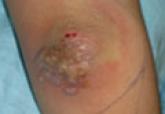Article

Multiple Keratoacanthomas Arising Within Red Tattoo Pigment
- Author:
- Dawn Queen, BA
- Lindsey E. Richards, MD
- Lindsey Bordone, MD
- David R. Bickers, MD
- Sameera Husain, MD
- Jesse M. Lewin, MD
Tattoo reactions range from infectious and inflammatory dermatoses to the development of malignant neoplasms. This case provides evidence of an...
Article

Herpes Simplex Virus–Associated Pseudolymphoma
- Author:
- Jesse M. Lewin, MD
- Rachel Farley-Loftus, MD
- Miriam Keltz Pomeranz, MD
Pseudolymphomas consist of benign reactive T- or B-cell lymphoproliferative processes that clinically and/or histologically simulate cutaneous...
